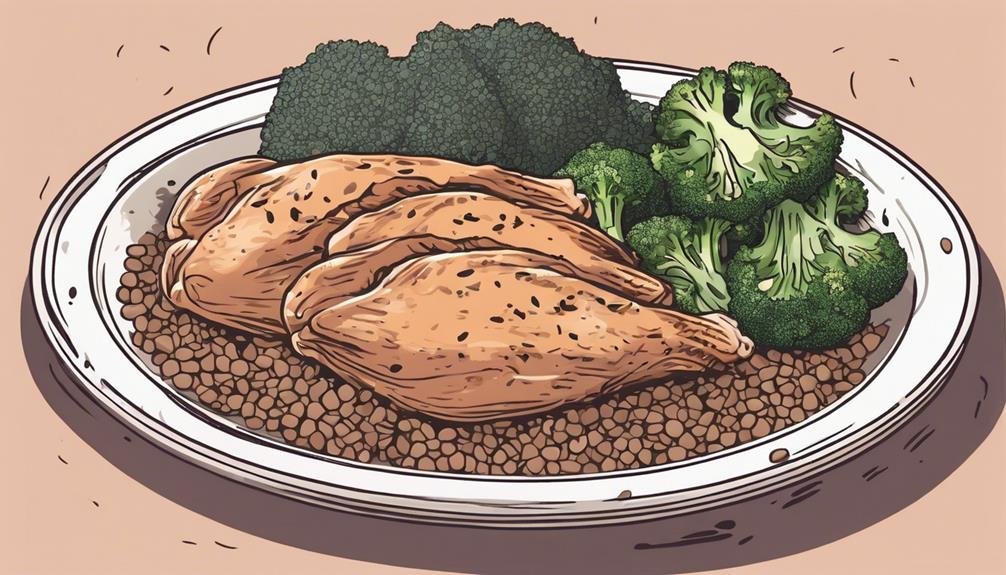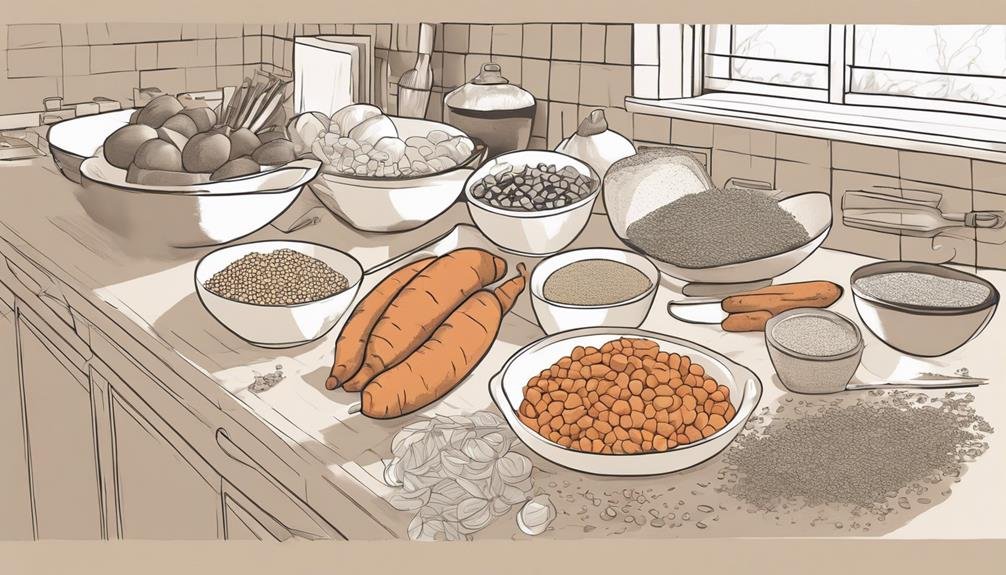10 Tips for Optimal Macro Balance After 40
To achieve ideal macro balance after 40, focus on your macronutrients: proteins, fats, and carbohydrates. Prioritize protein to support muscle retention, aiming for 0.8 to 1.2 grams per kilogram of body weight daily. Choose healthy fats like avocados and nuts, while opting for whole grains and plenty of fruits and vegetables for carbs. Stay hydrated to boost energy and consider your activity levels when adjusting your intake. Monitor portion sizes to manage weight effectively. If you'd like to explore more strategies for enhancing your nutrition and health, there's plenty more to discover that can help you thrive.
Key Takeaways
- Prioritize protein intake by consuming 0.8 to 1.2 grams per kilogram of body weight daily to maintain muscle mass after 40.
- Choose healthy fats like avocados and olive oil to support heart health and enhance nutrient absorption.
- Select nutrient-dense carbohydrates, such as whole grains and vegetables, to stabilize energy levels and avoid crashes.
- Incorporate fiber-rich foods like fruits and legumes to improve digestion and increase satiety; aim for at least 25 grams daily.
Understand Your Macronutrients
To enhance your health after 40, you need to grasp the role of macronutrients in your diet.
Macronutrients—proteins, fats, and carbohydrates—are essential for fueling your body and maintaining overall well-being.
Proteins are important for muscle repair and growth, especially as you age. Fats provide energy and support cell health, while also aiding in nutrient absorption. Carbohydrates serve as your body's primary energy source, especially for active individuals.
Understanding how these macronutrients work together enables you to make better food choices.
Aim for a balanced intake that suits your lifestyle, activity level, and health goals. By prioritizing the right macronutrients, you'll set a solid foundation for the best health and well-being in your 40s and beyond.
Calculate Your Macro Needs
Calculating your macro needs is essential for tailoring your diet to support your health and fitness goals after 40. Start by determining your daily caloric intake based on your activity level and goals. Then, you can allocate your macronutrients: proteins, fats, and carbohydrates. A common ratio is 30% protein, 30% fat, and 40% carbohydrates, but you can adjust these based on personal goals.
| Macronutrient | Grams per Day | % of Total Calories |
|---|---|---|
| Protein | 150g | 30% |
| Fat | 67g | 30% |
| Carbohydrates | 200g | 40% |
Using this table, you can easily track and adjust your intake for best results.
Prioritize Protein Intake

Prioritizing protein intake is essential for maintaining muscle mass and supporting overall health as you age.
As you hit your 40s and beyond, your body naturally loses muscle, which can affect strength and metabolism.
Aim to include a source of protein in every meal and snack. This could be lean meats, fish, eggs, dairy, legumes, or plant-based options like tofu.
A good rule of thumb is to target around 0.8 to 1.2 grams of protein per kilogram of body weight daily, adjusting based on activity levels and health goals.
Distributing your protein intake throughout the day helps maximize muscle protein synthesis.
Choose Healthy Fats
Incorporating healthy fats into your diet is essential for supporting heart health, brain function, and overall well-being as you age. Focus on unsaturated fats, which can help reduce inflammation and improve cholesterol levels. Great sources include avocados, olive oil, nuts, and fatty fish. These fats not only enhance flavor but also provide crucial nutrients your body needs.
Here's a quick reference table to guide your choices:
| Healthy Fats | Benefits | How to Use |
|---|---|---|
| Avocados | Rich in monounsaturated fats | Spread on toast or salads |
| Olive Oil | Anti-inflammatory | Use for cooking or dressings |
| Nuts (Almonds, Walnuts) | High in omega-3s | Snack on them or add to oatmeal |
| Fatty Fish (Salmon) | Heart-healthy | Grill or bake for meals |
| Chia Seeds | Omega-3 and fiber | Add to smoothies or yogurt |
Control Carbohydrate Sources

Balancing your intake of healthy fats with the right carbohydrate sources can greatly impact your energy levels and overall health as you age.
Choosing the right carbs is essential. Instead of reaching for sugary snacks, focus on nutrient-dense options that sustain your energy throughout the day.
Consider these tips for selecting your carbs wisely:
- Opt for whole grains like brown rice, quinoa, or whole-wheat pasta to keep you full longer.
- Include fruits and vegetables for their vitamins, minerals, and antioxidants, which support your immune system.
Incorporate Fiber-Rich Foods
Adding fiber-rich foods to your diet boosts digestion and keeps you feeling satisfied longer. These foods, such as fruits, vegetables, whole grains, and legumes, not only enhance your gut health, but they also help regulate blood sugar levels. Aim for at least 25 grams of fiber daily for ideal benefits.
Start your day with oatmeal topped with berries, or enjoy a hearty salad filled with leafy greens and chickpeas for lunch. Snacking on nuts or fresh fruit can also contribute to your fiber intake.
Don't forget about fiber supplements if you struggle to meet your needs through food alone. By incorporating these fiber-rich options, you'll support your overall health and maintain a balanced macro intake effectively.
Stay Hydrated

Staying hydrated is essential for maintaining your energy levels and supporting overall health, especially as you age.
As your body's water content decreases, it's vital to drink enough fluids to keep everything functioning smoothly.
Here are some tips to help you stay hydrated:
- Carry a water bottle: Having water on hand makes it easier to sip throughout the day.
- Infuse your water: Add fruits or herbs for a revitalizing twist that encourages you to drink more.
Monitor Portion Sizes
Regularly monitoring portion sizes can greatly impact your health and weight management as you age. As metabolism slows, it's crucial to be mindful of how much you're eating.
Start by using smaller plates or bowls, which can help you control your portions visually. Measure out servings of grains, proteins, and fats to understand better what a healthy portion looks like.
Pay attention to hunger cues; eat when you're hungry and stop when you're satisfied—not stuffed. Avoid distractions while eating, like watching TV, so you can focus on your meal.
Adjust Based on Activity

As you monitor portion sizes, it's important to adjust your food intake based on your activity level to maintain ideal health and weight.
When you're more active, your body requires additional nutrients to fuel performance and recovery. Conversely, on less active days, you might need to scale back.
Here are some tips to help you fine-tune your macros:
- Increase carbs on workout days to boost energy and replenish glycogen stores.
- Focus on protein during recovery days to support muscle repair and growth.
Consider Supplementation Options
Considering the unique nutritional needs after 40, exploring supplementation options can enhance your overall health and support your macro balance.
As your metabolism slows and nutrient absorption may decline, specific supplements can play an essential role.
For protein, consider whey or plant-based protein powders to help meet your daily requirements. Omega-3 fatty acids can support heart health and reduce inflammation, so adding a quality fish oil or algae-based supplement might be beneficial.
Additionally, vitamins D and B12 are important for bone health and energy levels, respectively.
Always consult with a healthcare professional before adding supplements to confirm they fit your specific needs.
Questions
How Does Metabolism Change After Age 40?
As you age past 40, your metabolism slows down due to hormonal changes, decreased muscle mass, and lower energy expenditure. This means you might need to adjust your diet and exercise routine accordingly.
Can I Lose Weight While Maintaining Muscle Mass?
Yes, you can lose weight while maintaining muscle mass. Focus on a high-protein diet, strength training, and a moderate calorie deficit. Consistency and proper recovery are key to achieving your goals effectively.
What Role Does Stress Play in Macro Balance?
Stress acts like a storm cloud, overshadowing your macro balance. It can lead to cravings for unhealthy foods, disrupt digestion, and hinder muscle recovery. Managing stress helps you maintain better control over your nutrition choices and overall health.
Are There Specific Foods to Avoid After 40?
You should avoid processed foods, added sugars, and excessive saturated fats. These can lead to weight gain and health issues. Instead, focus on whole foods that nourish your body and support your overall well-being.
How Often Should I Reevaluate My Macro Plan?
You should reevaluate your macro plan every few months or after significant changes in your lifestyle, activity level, or goals. Regular assessments help you stay on track and adjust for ideal results as your needs evolve.
Conclusion
Just like a skilled gardener tending to a diverse garden, you need to nurture your body with the right balance of macronutrients.
By understanding your unique needs and adjusting your approach as you grow, you can cultivate a vibrant lifestyle.
Remember, every meal is a chance to plant seeds of health.
With a little care and attention, you'll reap the rewards of energy and liveliness, ensuring your wellness blooms beautifully well beyond the age of 40.

